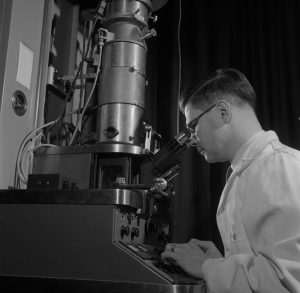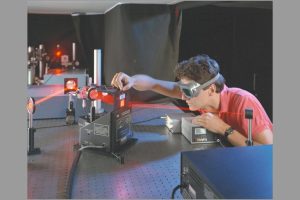Kimberly M. Tarvis
INVENTION IS SOMETIMES A PROCESS OF “OOPS”!
Many technologies have multiple creators at different times, with origins that were not their first intention. One that is highly recognizable is the slinky. This thin, metal spring-like toy has fascinated children since the 1940’s (Townsend, 2011). Created by Richard James, a mechanical engineer, as many good unintended things, by accident (Townsend, 2011). Lallensack (2019) describes the story goes that when Richard was trying to fit springs he had developed for naval ship instrumentation mountings, he accidentally nudged a shelf of springs that fell to the floor. He watched the spring continue to move from a shelf to the floor, plopping from one end to the other, end over end.

From the initial intention of instrument stabilization on marine vessels to now one of the most iconic toys of the twentieth century, Richard could not have imagined that the Slinky would fascinate generations of children for years to come.
The story of the slinky is not the only one that we hear about where technology’s initial intention turned in a completely different direction. The holograph’s history is one that stems from a few different scientific discoveries. As with any area of technology, it is often difficult to find the moment in which the technology was first created, especially before the advent of computers and the internet! Yes, we can go back and know exactly when the first cellular phone was developed, but whole areas of technological advance are interwoven with many different scientists, artists, designers, and even unknowing researchers in areas where the initial intention of the technology was for something completely different.
IT ALL BEGAN WITH A MICROSCOPE

The fascination with seeing more clarified and realistic images under a microscope has pushed scientists to develop technologies that have advanced many other areas of research. From the invention of van Leuwenhoek’s first microscope in the late 1600’s to the present-day microscopes that are hands-free with 4K resolution and more powerful optics than the human eye can process, we have come a long way in seeing the “unseen” (Poppick, 2017). This is the case with holographic technology. Dr. Dennis Gabor, a physicist working for British Thomson-Houston, a subsidy of General Electric in the United Kingdom, wanted to increase the capabilities of the electron microscope, specifically its resolution (Odelberg, 1972). In 1947, he theorized that in order to do this, he needed a coherent light source (Gabor, 1948). Coherent is a term uses in physics to describe a wave of light where the wave’s frequency and waveform, or shape of the wave of light, are the same (Gabor, 1972).
How did the term “holograph” develop? Holograph was first used by Gabor himself, from two Greek words: “holos” meaning “whole” and “gamma” meaning “message” (Johnston, 2011). Now, at this point in history, Gabor had only his theory on holography, and he did not work with images created by the technology itself. Why? Because the technology did not exist at that point! The closest light source to a true coherent wave was the mercury arc lamp, which after Gabor’s ground-breaking publications on the theory of holography were published, began the true work in holographic technology for imaging (Gabor, 1972). For his work with holographic technology, specifically the theory of holography, Dennis Gabor won the Nobel Prize for Physics in 1971, after devoting his career to the advancement of improved imaging for years to come (Odelberg, 1972).
In this YouTube video, Dr. Dennis Gabor is interviewed on November 2, 1971 about receiving the Nobel Prize in Physics for his work on the theory of holography (AP Archive, 2015).
LASERS, THE LIGHT AT THE END OF THE HOLOGRAM
As Gabor (1972) describes, the theory of holography was rooted in the use of a coherent light source, which was not discovered at the time. Almost two decades later in 1960, the first coherent light source was invented, the laser. Two years later, Dr.’s Emmett Leith and Juris Upatnieks from the University of Michigan, proposed that holographs could be produced using a laser light source (1962). This in turn would produce a 3-D image, with the application of Gabor’s theory of holography. And wow, they were right! Leith and Upatnieks (1962) were able to transmit the first 3-D holographic image using a laser. Not only were the two researchers able to create a holographic image, they were also able to produce an image that was both realistic and clear to view. Their method of producing a 3-D holographic image is still used to this day as the tried-and-true procedure!
The holographic imaging procedure developed by Leith and Upatnieks (1962), dubbed the basic off-axis technique, uses just a few simple tools to obtain a holographic image:

- A continuous wave laser
- Optical devices to direct the laser beam, including:
- Lens
- Mirrors
- Beam splitter
- Film holder
- Isolation table where the image is made, also known as an exposure
The next chapter describes how a holographic image is produced in detail, using these simple pieces of equipment to create the holograph.
FURTHER DEVELOPMENT OF HOLOGRAPHIC TECHNOLOGY
From the 1960’s the early 1980’s, holographic technology grew in leaps and bounds (Johnston, 2011). Moving from a simple image to moving images to even a rainbow image that is now used in many different applications, including packaging, banking, security, advertising, and other industries (HoloCenter, 2022). Below is a timeline for further developments of holographic technology after the Off-Axis technique was first introduced (Thun, 2012):

References:
AP Archive. (2015, August 4). Synd 3-11-71 Interview with Nobel scientist Dennis Gabor [Video]. YouTube. https://www.youtube.com/watch?v=rnIGSCjRE2E
Gabor, D. (1948). A new microscopic principle. Nature, 161(1947), 777-778. https://doi.org/10.1038/161777a0
Gabor, D. (1972). Holography, 1948-1971. Science, 177(4046), 299-313. https://doi.org/10.1126/science.177.4046.299
HoloCenter for the Holographic Arts. (2022). Different Types of Holograms. HoloCenter. https://holocenter.org/what-is-holography/different-types-of-holograms
Johnston, S. F. (2011). Whatever became of holography?. American Scientist, 99(6), 482. https://doi.org/10.1511/2011.93.482
Lallensack, R. (2019, August 29). The accidental invention of the slinky. Smithsonian Magazine. https://www.smithsonianmag.com/innovation/accidental-invention-slinky-180973016/
Leith, E. N., & Upatnieks, J. (1962). Reconstructed wavefronts and communication theory. Journal of the Optical Society of America, 52(10), 1123-1130. https://doi.org/10.1364/JOSA.52.001123
Odelberg, W. (Ed.). (1972). The Nobel prizes. Nobel Foundation.
Poppick, L. (2017, March 30). Let us now praise the invention of the microscope. Smithsonian Magazine. https://www.smithsonianmag.com/science-nature/what-we-owe-to-the-invention-microscope-180962725/
Thun, L. (2012). Holography Timeline. https://235bowery.s3.amazonaws.com/exhibitionlinks/62/Holography_Timeline.pdf
Townsend, A. (2011, February 16). All-TIME 100 greatest toys: Slinky. TIME. http://content.time.com/time/specials/packages/article/0,28804,2049243_2048651_2049036,00.html
